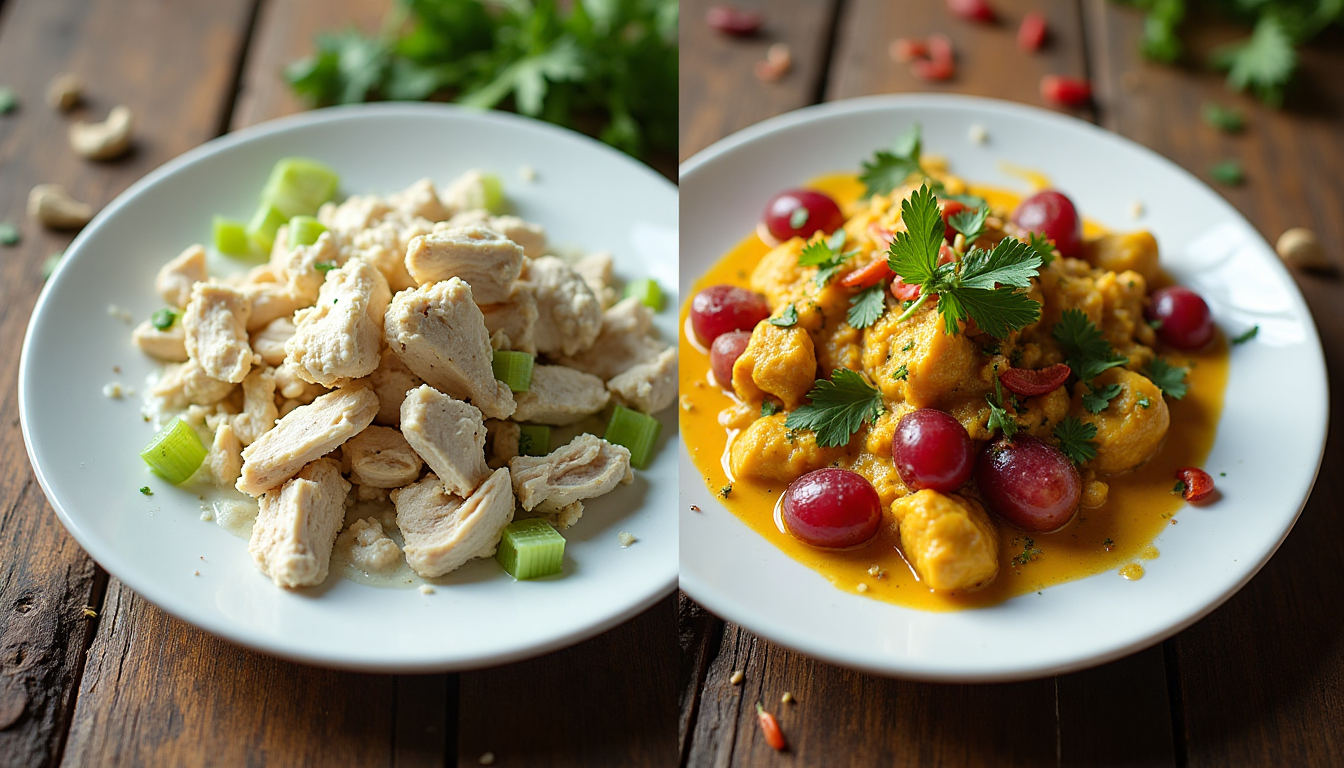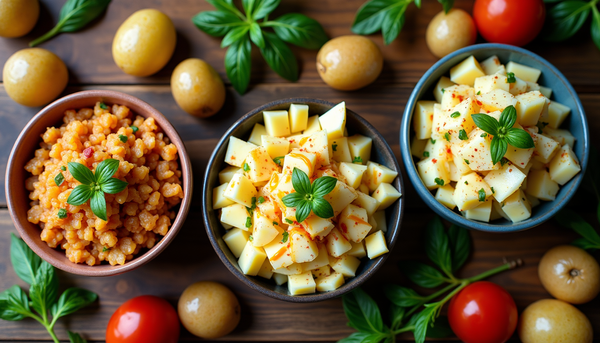Stop Making "Healthy" Swaps and Start Building Better Flavors

The Great Greek Yogurt Lie (And Why Your Curry Chicken Salad Doesn't Have to Suck)
Okay, confession time. Last month I made the world's most depressing chicken salad. Picture this: sad, dry chunks of overcooked chicken swimming in what I can only describe as tangy white paste, with some wilted celery thrown in for "crunch." The recipe promised it was a "healthy makeover" of classic chicken salad, and technically? It delivered. It was definitely healthier than the original. It was also completely inedible.
My kids took one look, wrinkled their noses, and asked if we could just have peanut butter sandwiches instead. Honestly? Fair request.
But here's the thing that's been bugging me about the whole "healthy recipe makeover" trend - and trust me, I've fallen into this trap more times than I care to admit. We've gotten so obsessed with swapping out "bad" ingredients for "good" ones that we've forgotten the most important rule of cooking: it has to taste good, or what's the point?
The Substitution Trap is Real
I see it everywhere. Greek yogurt for mayo! Cauliflower for rice! Zucchini for pasta! And look, I'm not anti-vegetable or anti-Greek yogurt. But when did we decide that cooking was just an elaborate game of ingredient Jenga, where we see how many things we can swap out before the whole dish collapses?
The problem with the substitution mindset is that it starts from a place of restriction instead of possibility. You're not thinking "how can I make this taste amazing?" You're thinking "how can I make this taste acceptable while hitting my macro targets?"
No wonder so many "healthy" recipes taste like punishment.
What Actually Makes Food Taste Good (Spoiler: It's Not What You Think)
Here's what I've learned after years of kitchen experimentation (and honestly, quite a few failures): the magic isn't in the ingredients themselves. It's in understanding WHY certain combinations work.
Take traditional chicken salad. Why does it work? It's not because mayo is some kind of miracle ingredient. It works because you've got:
- Richness that coats your mouth and carries flavors
- Acidity that brightens everything up
- Salt that makes your taste buds pay attention
- Texture contrast between creamy and crunchy
- Temperature that feels satisfying
Once you understand the architecture of flavor, you can build something new instead of just swapping parts.
Enter: The Curry Chicken Salad That Actually Gets It
This is where curry chicken salad becomes genius. Not because it's "healthier" (though it happens to be), but because it solves the flavor equation in a completely different way.
Instead of relying on mayo for richness, curry spices create warmth and complexity. The sweetness from grapes plays against the heat from ginger. Fresh herbs add brightness that's way more interesting than just squeezing lemon on everything.
And here's the kicker - when you build flavors instead of substituting them, you actually want to eat more vegetables. Revolutionary concept, right?
My Version (Because I Can't Leave Well Enough Alone)
I've been making this recipe for about two years now, ever since I had a minor existential crisis in the Trader Joe's parking lot about spending $8 on what's essentially chicken with seasoning. And like any recipe I make more than twice, it's evolved.
For the chicken salad:
- 1 pound cooked chicken (I use thighs because life's too short for dry chicken)
- 1 cup red grapes, halved (don't skip this step - whole grapes are a textural nightmare)
- 1/2 cup cilantro, roughly chopped (or mint if cilantro tastes like soap to you)
- 1/2 cup shredded carrots
- 1/3 cup toasted cashews, roughly chopped
- 1/4 cup red onion, finely diced
For the curry sauce that doesn't suck:
- 1 cup thick Greek yogurt (get the good stuff)
- 1 tablespoon fresh lemon juice
- 1 tablespoon honey
- 1 teaspoon garam masala
- 1/2 teaspoon ground ginger
- 1/2 teaspoon turmeric
- Salt and black pepper to taste
Mix the sauce ingredients first and taste as you go. This is important - your spice blend might be different than mine, your yogurt might be tangier, your lemons might be more or less acidic. Cooking isn't chemistry; it's jazz. Go with what tastes good to you.
Then just toss everything together. Seriously, that's it. The only slightly tricky part is letting it sit for at least 30 minutes before serving so the flavors can get acquainted.
The Small Details That Make a Big Difference
Chicken temperature matters. If you're using freshly cooked chicken, let it cool completely before mixing or you'll end up with warm, wilty vegetables and nobody wants that texture situation.
**Toast your cashews.**5 minutes in a dry skillet. Trust me on this one - it's the difference between "meh" crunch and "where has this been all my life" crunch.
Grape size consistency. I know it seems obsessive, but when all your grape pieces are roughly the same size, you get consistent bursts of sweetness instead of random giant grape bombs.
Taste as you go. I cannot stress this enough. That final seasoning adjustment is what separates good food from great food. Maybe you need more salt, maybe more lemon, maybe a tiny bit more honey to balance the spices.
Beyond the Basic Bowl
Here's where this recipe really shines - it's ridiculously versatile. I've served it:
- In butter lettuce cups (classic and pretty)
- On sourdough toast with sliced avocado (carbs + fat = happiness)
- Stuffed in mini bell peppers for parties
- Mixed with quinoa for a more substantial meal
- As a fancy-ish appetizer on endive leaves
My teenager likes it in a wrap with extra lettuce. My partner prefers it with crackers. I usually just eat it straight from the container while standing in the kitchen, but that's probably not the vibe you're going for if you have guests.
The Real Talk About "Healthy" Cooking
Look, I'm not gonna stand here and pretend this is some kind of superfood miracle. It's chicken salad. But it is chicken salad that happens to be packed with protein, includes actual vegetables, and uses yogurt that gives you probiotics instead of mayo that gives you... well, mayo.
The point isn't that Greek yogurt is inherently superior to mayonnaise. The point is that when you build flavors thoughtfully, you end up with something that's both satisfying AND happens to fit into whatever eating style makes you feel good.
Your Turn to Experiment
Here's what I want you to try: next time you're looking at a "healthy makeover" recipe, ask yourself - am I just swapping ingredients, or am I actually building better flavors?
Try this curry chicken salad, but don't just follow the recipe blindly. Taste the sauce before you add it. Adjust the spice level. Maybe you want to add some dried cranberries, or swap cashews for pistachios, or throw in some diced apple for extra crunch.
The best recipes aren't the ones you follow perfectly - they're the ones that give you a foundation to build something that's perfectly yours.
And if you end up with something terrible? Well, that's what peanut butter sandwiches are for. But I'm betting you'll end up with something pretty great instead.
What's your biggest "healthy recipe fail" story? And more importantly - what did you learn from it? Drop a comment and let's commiserate over our kitchen disasters together. Because honestly, the best cooks are the ones who've messed up the most meals.
P.S. - If you make this and it turns out great, please don't say it "tastes healthy." Just say it tastes good. That's the whole point.




